Human Arm Workout Classification by Arm Sleeve Device Based on Machine Learning Algorithms
Abstract
:1. Introduction
2. Materials and Methods
2.1. Sensor Fabrication
2.2. Data Acquisition Protocol
2.3. Data Pre-Processing
2.4. Classification of Targeted Muscles during 3 Workouts
3. Results
3.1. Assessment of the Performance of Textile-Based Sensor
3.2. Assessment of the Machine Learning Models
4. Conclusions
Author Contributions
Funding
Institutional Review Board Statement
Informed Consent Statement
Data Availability Statement
Acknowledgments
Conflicts of Interest
References
- Firdaus, W.; Kuan, G.; Krasilshchikov, O. The effects of using complex training method on muscular strength among male weightlifters. J. Sains Sukan Pendidik. Jasm. 2018, 7, 1–12. [Google Scholar] [CrossRef]
- Wong, A.B.; Chen, D.; Chen, X.; Wu, K. Monitoring Neuromuscular Activity during Exercise: A New Approach to Assessing Attentional Focus Based on a Multitasking and Multiclassification Network and an EMG Fitness Shirt. Biosensors 2022, 13, 61. [Google Scholar] [CrossRef]
- Ng, C.L.; Reaz, M.B.I. Characterization of textile-insulated capacitive biosensors. Sensors 2017, 17, 574. [Google Scholar] [CrossRef] [Green Version]
- Fu, Y.; Zhao, J.; Dong, Y.; Wang, X. Dry electrodes for human bioelectrical signal monitoring. Sensors 2020, 20, 3651. [Google Scholar] [CrossRef]
- Guo, L.; Sandsjö, L.; Ortiz-Catalan, M.; Skrifvars, M. Systematic review of textile-based electrodes for long-term and continuous surface electromyography recording. Text. Res. J. 2020, 90, 227–244. [Google Scholar] [CrossRef] [Green Version]
- Shahandashti, P.F.; Pourkheyrollah, H.; Jahanshahi, A.; Ghafoorifard, H. Highly conformable stretchable dry electrodes based on inexpensive flex substrate for long-term biopotential (EMG/ECG) monitoring. Sens. Actuators A Phys. 2019, 295, 678–686. [Google Scholar] [CrossRef]
- Lam, E.; Alizadeh-Meghrazi, M.; Schlums, A.; Eskandarian, L.; Mahnam, A.; Moineau, B.; Popovic, M.R. Exploring textile-based electrode materials for electromyography smart garments. J. Rehabil. Assist. Technol. Eng. 2022, 9, 20556683211061995. [Google Scholar] [CrossRef]
- Niu, X.; Gao, X.; Liu, Y.; Liu, H. Surface bioelectric dry Electrodes: A review. Measurement 2021, 183, 109774. [Google Scholar] [CrossRef]
- Kim, H.; Kim, S.; Lim, D.; Jeong, W. Development and characterization of embroidery-based textile electrodes for surface EMG detection. Sensors 2022, 22, 4746. [Google Scholar] [CrossRef]
- Murciego, L.P.; Komolafe, A.; Peřinka, N.; Nunes-Matos, H.; Junker, K.; Díez, A.G.; Lanceros-Méndez, S.; Torah, R.; Spaich, E.G.; Dosen, S. A Novel Screen-Printed Textile Interface for High-Density Electromyography Recording. Sensors 2023, 23, 1113. [Google Scholar] [CrossRef]
- Xue, Y.; Yu, Y.; Yin, K.; Li, P.; Xie, S.; Ju, Z. Human in-hand motion recognition based on multi-modal perception information fusion. IEEE Sens. J. 2022, 22, 6793–6805. [Google Scholar] [CrossRef]
- Colli Alfaro, J.G.; Trejos, A.L. User-independent hand gesture recognition classification models using sensor fusion. Sensors 2022, 22, 1321. [Google Scholar] [CrossRef]
- Alizadeh-Meghrazi, M.; Sidhu, G.; Jain, S.; Stone, M.; Eskandarian, L.; Toossi, A.; Popovic, M.R. A mass-producible washable smart garment with embedded textile EMG electrodes for control of myoelectric prostheses: A pilot study. Sensors 2022, 22, 666. [Google Scholar] [CrossRef]
- Kumar, G.; Yadav, S.S.; Pal, V. Machine learning-based framework to predict finger movement for prosthetic hand. IEEE Sens. Lett. 2022, 6, 1–4. [Google Scholar] [CrossRef]
- Vu, C.C.; Kim, J. Human motion recognition by textile sensors based on machine learning algorithms. Sensors 2018, 18, 3109. [Google Scholar] [CrossRef] [Green Version]
- Farina, D.; Jiang, N.; Rehbaum, H.; Holobar, A.; Graimann, B.; Dietl, H.; Aszmann, O.C. The extraction of neural information from the surface EMG for the control of upper-limb prostheses: Emerging avenues and challenges. IEEE Trans. Neural Syst. Rehabil. Eng. 2014, 22, 797–809. [Google Scholar] [CrossRef]
- Bi, L.; Guan, C. A review on EMG-based motor intention prediction of continuous human upper limb motion for human-robot collaboration. Biomed. Signal Process. Control. 2019, 51, 113–127. [Google Scholar] [CrossRef]
- Parajuli, N.; Sreenivasan, N.; Bifulco, P.; Cesarelli, M.; Savino, S.; Niola, V.; Esposito, D.; Hamilton, T.J.; Naik, G.R.; Gunawardana, U. Real-time EMG based pattern recognition control for hand prostheses: A review on existing methods, challenges and future implementation. Sensors 2019, 19, 4596. [Google Scholar] [CrossRef] [Green Version]
- Jia, G.; Lam, H.-K.; Liao, J.; Wang, R. Classification of electromyographic hand gesture signals using machine learning techniques. Neurocomputing 2020, 401, 236–248. [Google Scholar] [CrossRef]
- Burgess, M.D.; Lui, F. Anatomy, Bony Pelvis and Lower Limb, Pelvic Bones. In StatPearls [Internet]; StatPearls Publishing: St. Petersburg, FL, USA, 2022. [Google Scholar]
- Reaz, M.; Hussain, M.; Mohd-Yasin, F. Techniques of EMG signal analysis: Detection, processing, classification and applications (Correction). Biol. Proced. Online 2006, 8, 163. [Google Scholar] [CrossRef] [Green Version]
- Jung, H.; Seo, J.; Seo, K.; Kim, D.; Park, S. Detection of muscle activation during resistance training using infrared thermal imaging. Sensors 2021, 21, 4505. [Google Scholar] [CrossRef]
- Abate, M.; Di Carlo, L.; Di Donato, L.; Romani, G.; Merla, A. Comparison of cutaneous termic response to a standardised warm up in trained and untrained individuals. J. Sports Med. Phys. Fit 2013, 26, 18–37. [Google Scholar]
- Hildebrandt, C.; Zeilberger, K.; Ring, E.J.; Raschner, C. The application of medical infrared thermography in sports medicine. In An International Perspective on Topics in Sports Medicine and Sports Injury; IntechOpen: London, UK, 2012; Volume 534. [Google Scholar]
- Bardy, E.; Mollendorf, J.; Pendergast, D. A comparison of the thermal resistance of a foam neoprene wetsuit to a wetsuit fabricated from aerogel-syntactic foam hybrid insulation. J. Phys. D Appl. Phys. 2006, 39, 4068. [Google Scholar] [CrossRef]
- Moran, J.L.; Cottrill, A.L.; Benck, J.D.; Liu, P.; Yuan, Z.; Strano, M.S.; Buongiorno, J. Noble-gas-infused neoprene closed-cell foams achieving ultra-low thermal conductivity fabrics. RSC Adv. 2018, 8, 21389–21398. [Google Scholar] [CrossRef] [Green Version]
- Vu, C.C.; Kim, J. Fractal structures in flexible electronic devices. Mater. Today Phys. 2022, 27, 100795. [Google Scholar] [CrossRef]
- Artanto, D.; Sulistyanto, M.P.; Pranowo, I.D.; Pramesta, E.E. Drowsiness detection system based on eye-closure using a low-cost EMG and ESP8266. In Proceedings of the 2017 2nd International Conferences on Information Technology, Information Systems and Electrical Engineering (ICITISEE), Yogyakarta, Indonesia, 1–2 November 2017; pp. 235–238. [Google Scholar]
- Sampath Dakshina Murthy, A.; Karthikeyan, T.; Vinoth Kanna, R. Gait-based person fall prediction using deep learning approach. Soft Comput. 2021, 26, 12933–12941. [Google Scholar] [CrossRef]
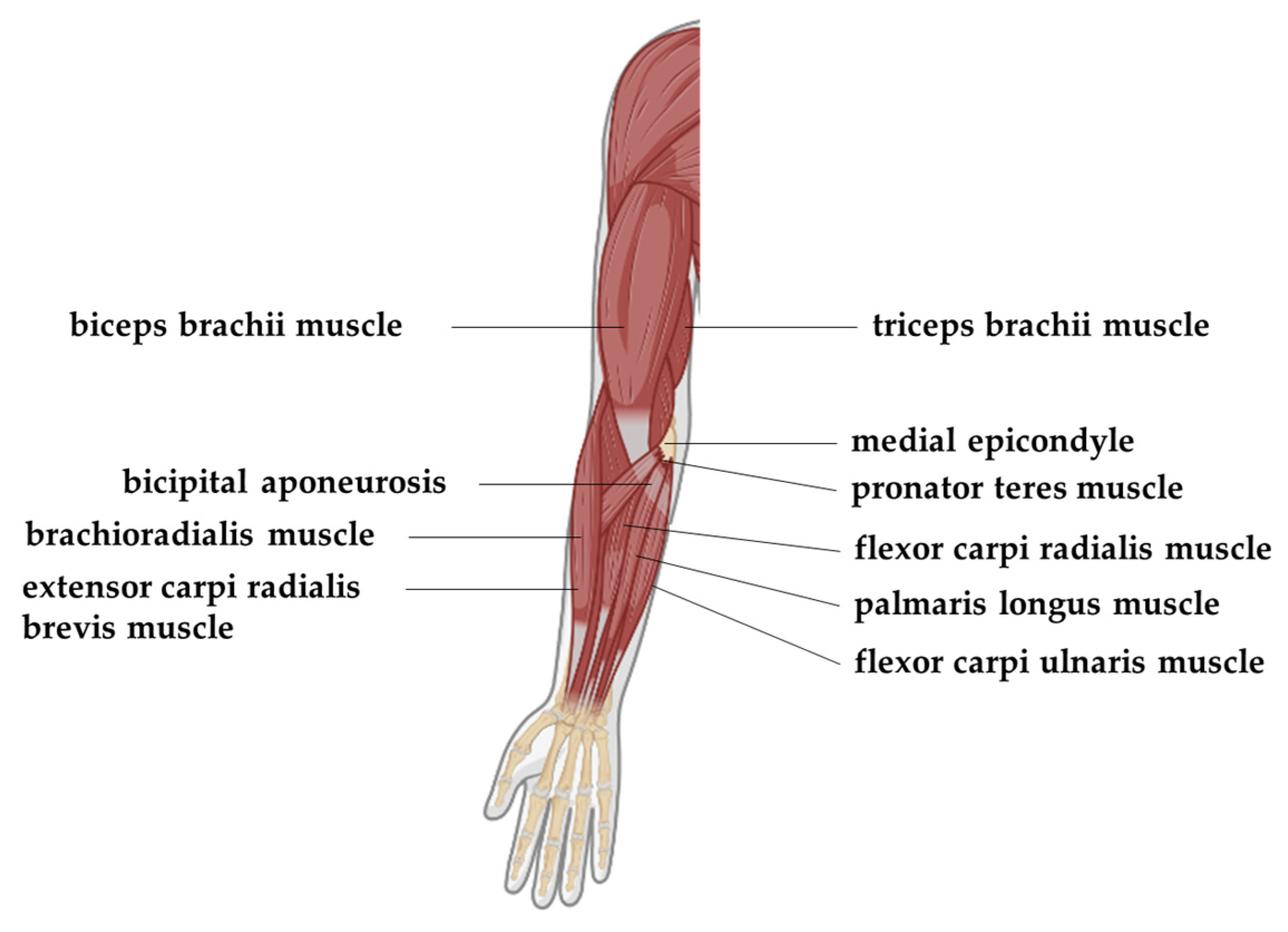
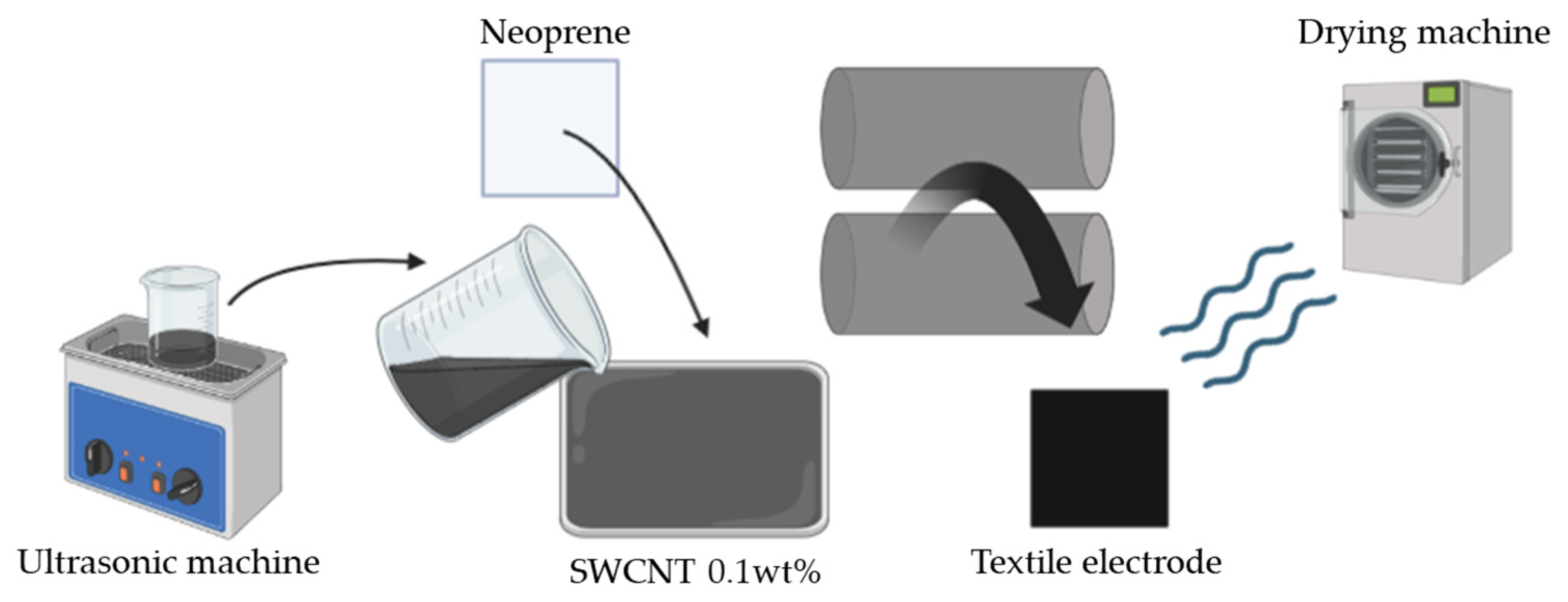
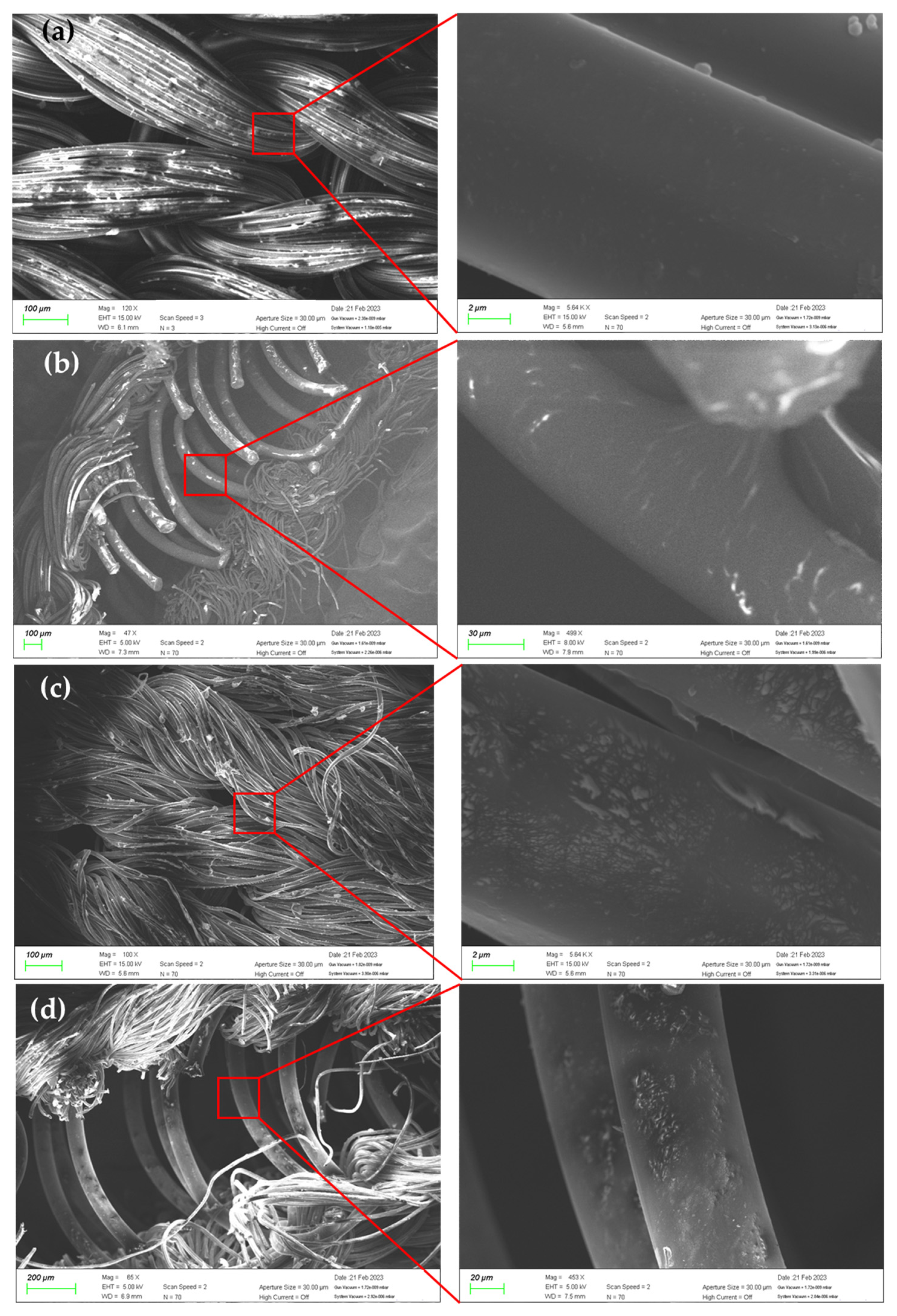
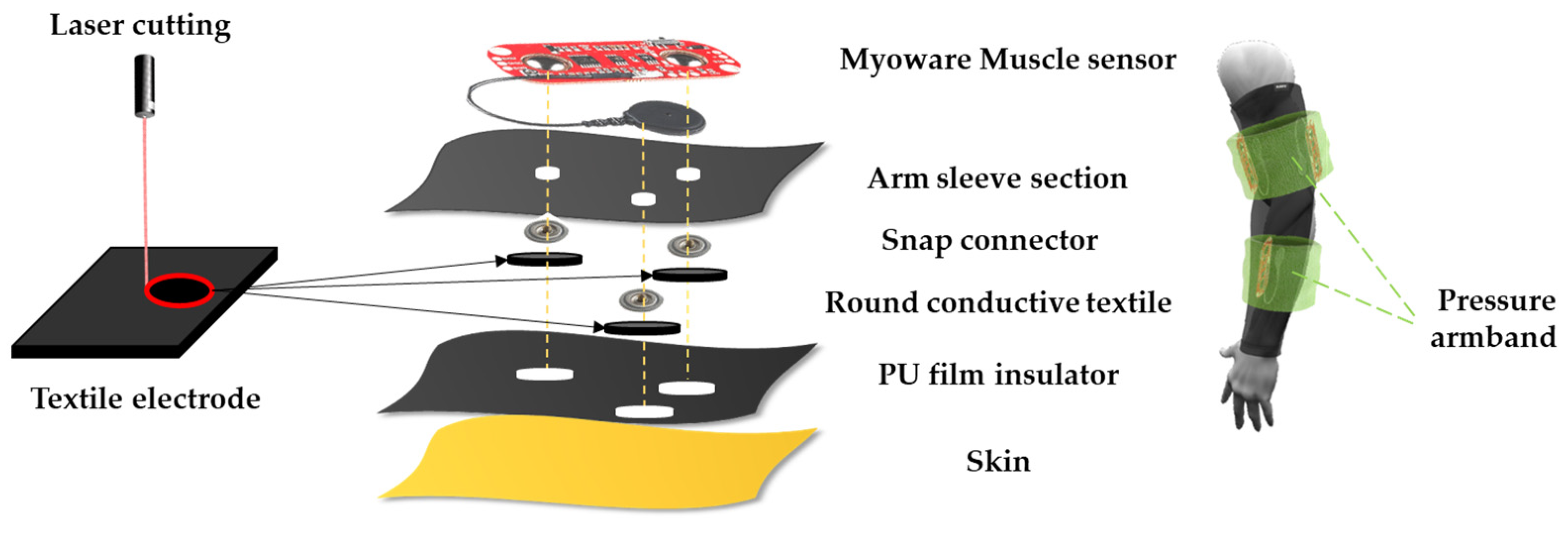


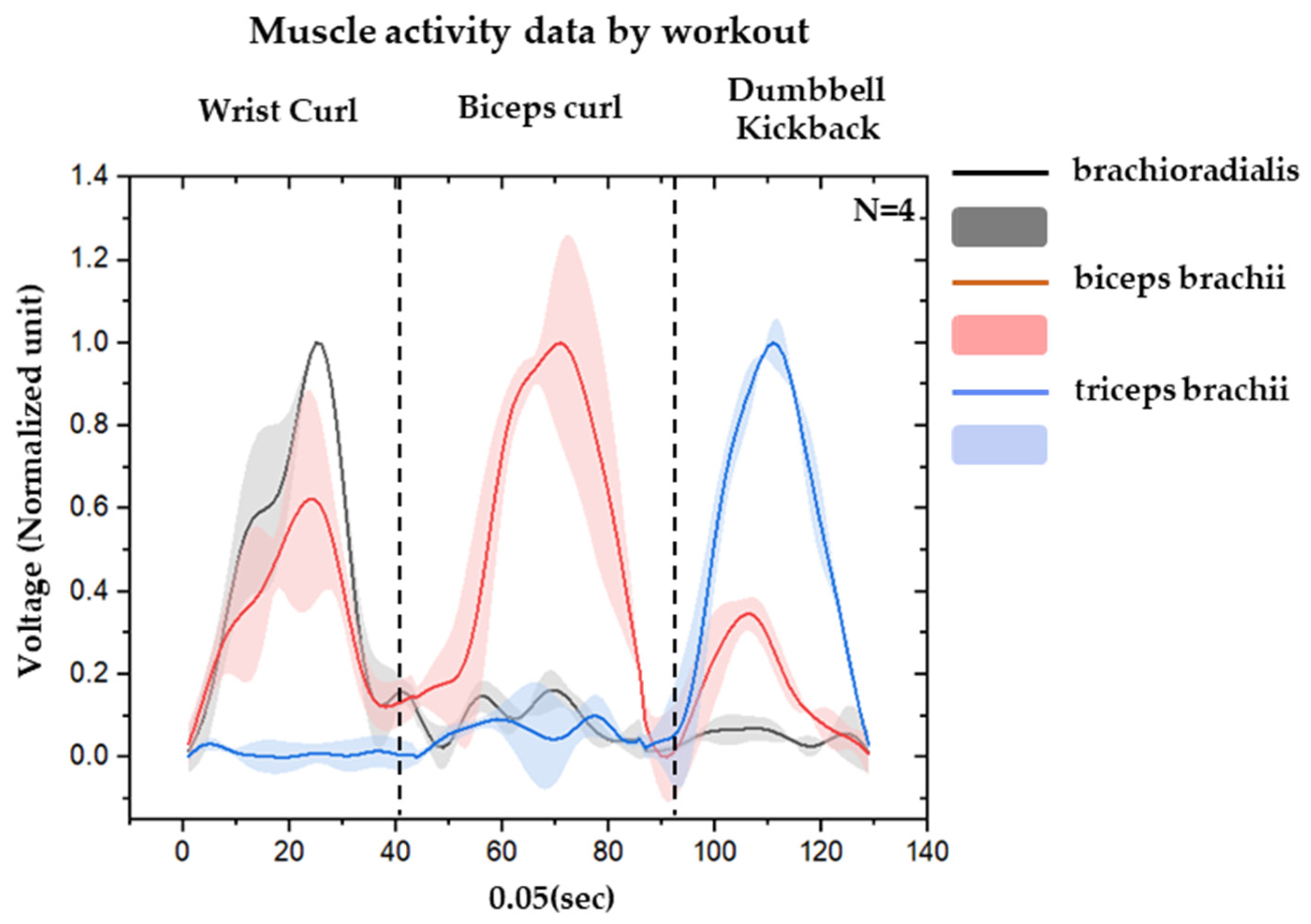

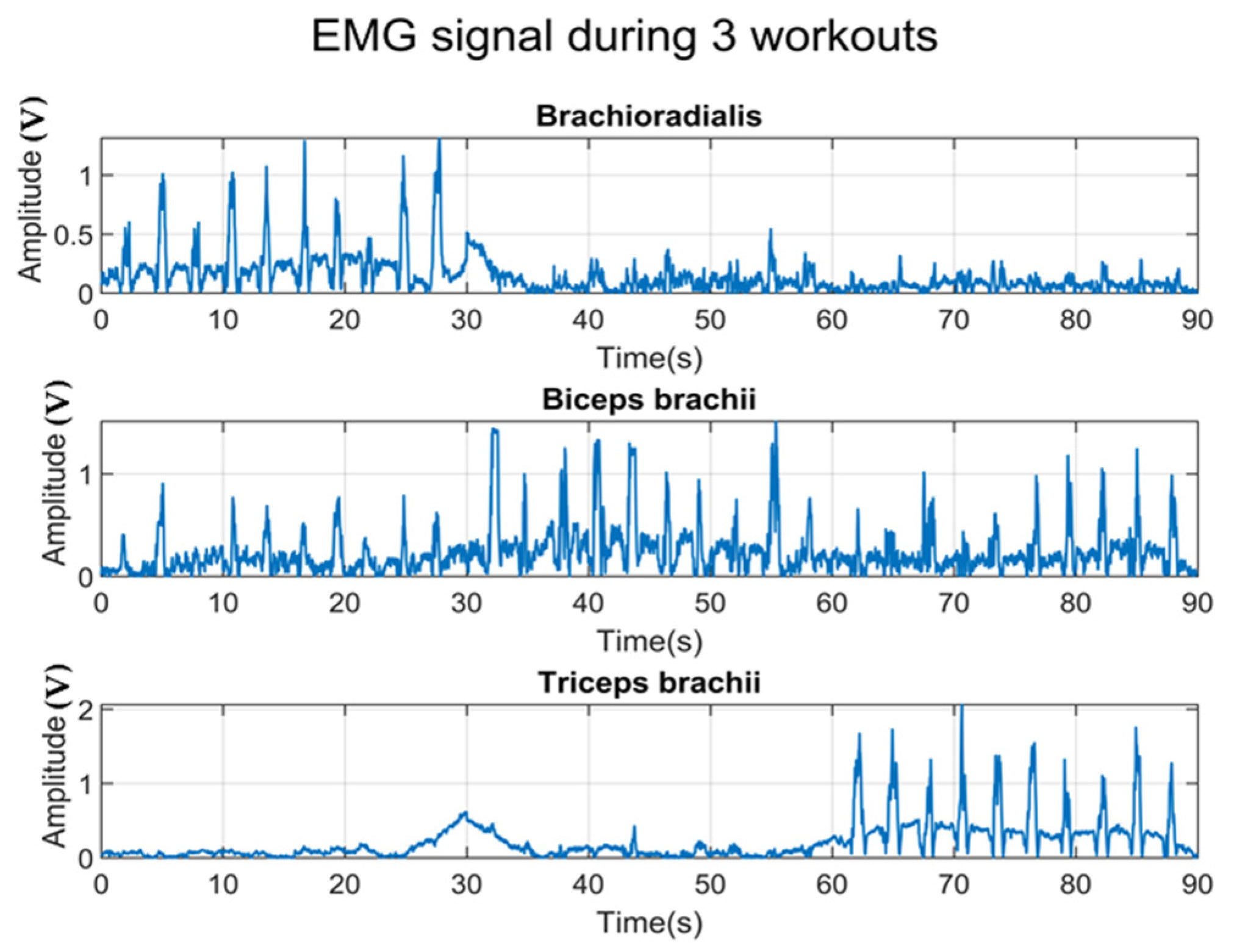
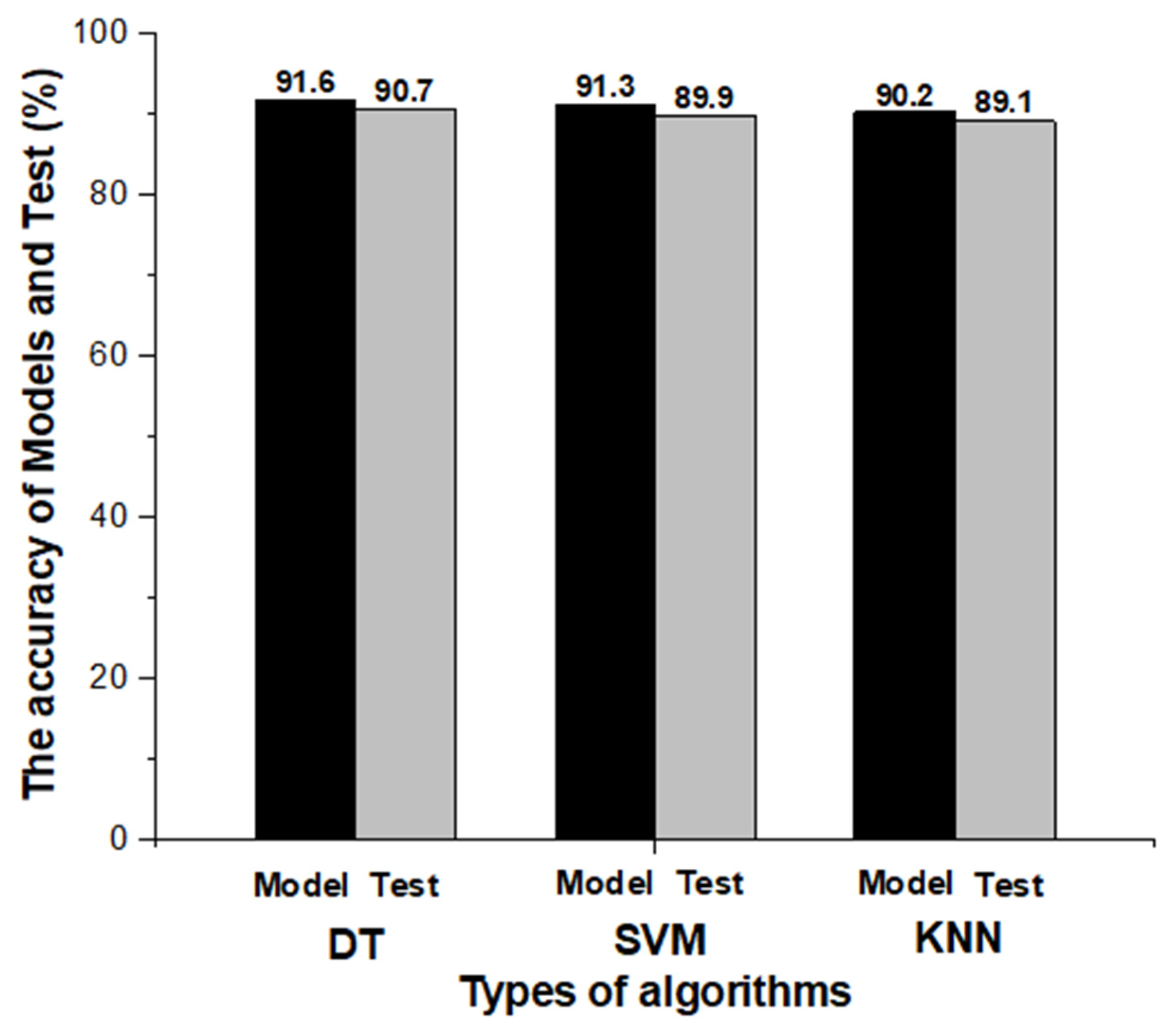

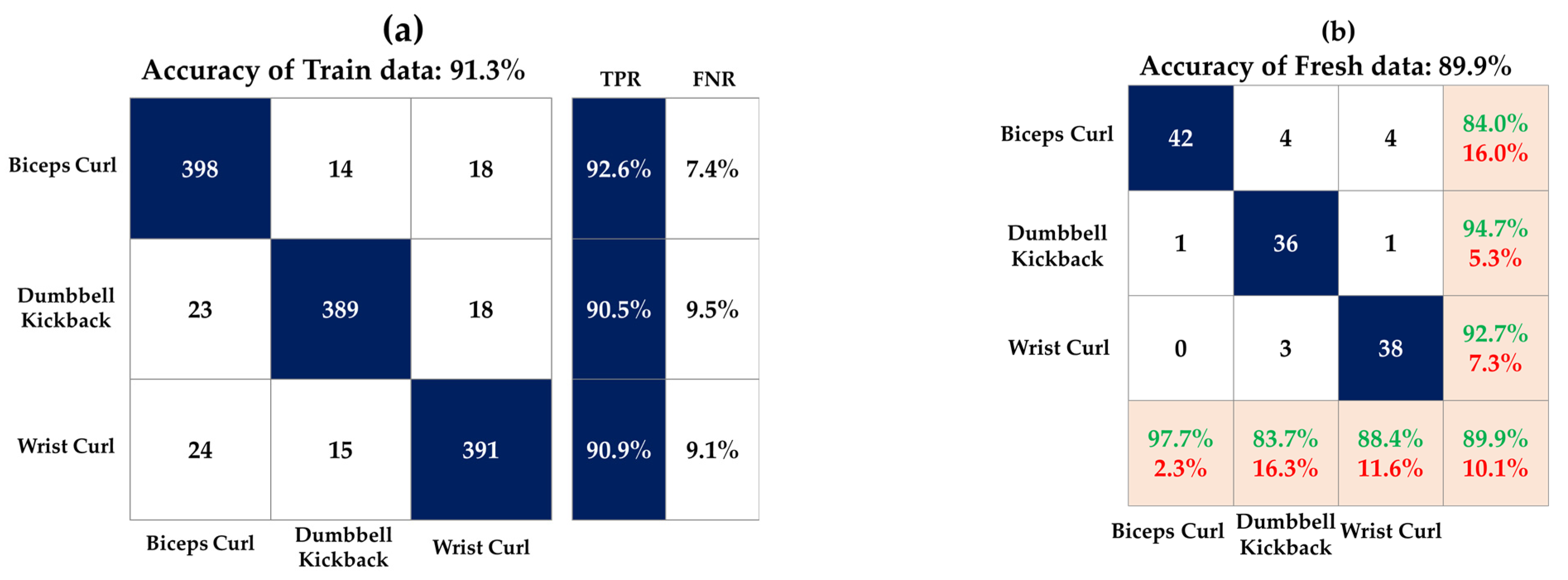


| Participant | Age | Gender | Height (m) | Arm Length (cm) Shoulder–Wrist |
|---|---|---|---|---|
| 1 | 28 | Male | 1.80 | 60 |
| 2 | 28 | Male | 1.82 | 63 |
| 3 | 28 | Male | 1.70 | 58 |
| 4 | 29 | Male | 1.78 | 69 |
Disclaimer/Publisher’s Note: The statements, opinions and data contained in all publications are solely those of the individual author(s) and contributor(s) and not of MDPI and/or the editor(s). MDPI and/or the editor(s) disclaim responsibility for any injury to people or property resulting from any ideas, methods, instructions or products referred to in the content. |
© 2023 by the authors. Licensee MDPI, Basel, Switzerland. This article is an open access article distributed under the terms and conditions of the Creative Commons Attribution (CC BY) license (https://creativecommons.org/licenses/by/4.0/).
Share and Cite
Chun, S.; Kim, S.; Kim, J. Human Arm Workout Classification by Arm Sleeve Device Based on Machine Learning Algorithms. Sensors 2023, 23, 3106. https://doi.org/10.3390/s23063106
Chun S, Kim S, Kim J. Human Arm Workout Classification by Arm Sleeve Device Based on Machine Learning Algorithms. Sensors. 2023; 23(6):3106. https://doi.org/10.3390/s23063106
Chicago/Turabian StyleChun, Sehwan, Sangun Kim, and Jooyong Kim. 2023. "Human Arm Workout Classification by Arm Sleeve Device Based on Machine Learning Algorithms" Sensors 23, no. 6: 3106. https://doi.org/10.3390/s23063106
APA StyleChun, S., Kim, S., & Kim, J. (2023). Human Arm Workout Classification by Arm Sleeve Device Based on Machine Learning Algorithms. Sensors, 23(6), 3106. https://doi.org/10.3390/s23063106







